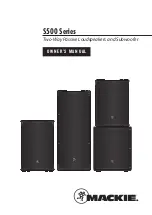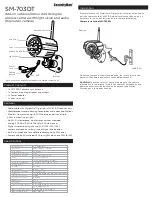
32
ID-E299-001GB
Mains power supply:
Three cable terminals are provided to connect 230 V/ 50 Hz mains wires and a
protection wire. The terminals are protected against incidental touch with a covering plate. In case
protection grounding is used (recommended), the protection wire should be connected to the bolt
placed inside the control panel on its side wall. The bolt is accessible after removing the protective
plate covering the mains connectors.
Detector lines:
The detection lines should be connected to the pairs of connectors with properly
marked polarisation. It is recommended to create detector lines using a screened cable certified by
an appropriate authority, e.g. in Poland – with YnTKSY ekw 1 x 2 x 0.8 cable certified by the CNBOP.
Terminals to connect the cable screens to the control panel metal cabinet are placed above the
detector line terminals - Fig. 4.
Monitoring lines (LK1…3):
The monitoring supervised lines, designed for external device status
monitoring, are provided with terminals with appropriately marked polarisation.
Alarm lines (LA1…3)
.
These lines are monitored and designed mainly to connect external acoustic
devices (option “0”, see p. 8.10). they can be also used for fire-fighting equipment control (option
“1”). To ensure proper monitoring and controlling of the connected signalling devices or other
equipment, the total line resistance should range from 200 Ω to 10 kΩ.
Fire alarm relay outputs:
Relay outputs, activated during a fire alarm, are designed to control
additional protecting devices or to transfer information about the control panel mode to a
monitoring centre. Every relay is equipped with a set of switchable contacts (NO, C, NC).
Fault signal relay output:
- P25 (in the ML1-1240 module)
Contacts of the general fault relay on the connection blocks (NO, C, NC) are marked in the position,
when the control panel is switched off from the supply voltage. During the control panel quiescent
mode, when no fault occurs, the relay is switched on. The contacts return to their ‘normal’ position
when any fault or supply voltage outage occurs. A typical application of the relay is a fault signal
transmission to a monitoring centre.
External device power supply output:
Two pairs of terminals (Z5 and Z6) supplying 24 V + 25 % - 15
% DC voltage in the MZ-4212 module, are designed for power supply of the external devices that are
activated e.g. from relay outputs. The positive terminal is protected with the BZ3 monitored fuse.
NOTES:
1.
In case external devices draw current also during quiescent mode, the operation time of the
control panel which is supplied from internal batteries during a mains (primary) power supply
outage, will decrease proportionally to the current consumption from the control panel and
will be shorter than 72 h. It is possible to connect external batteries of higher capacity.
2.
Connection of high inductance devices, such as relay coils, electromagnets, etc. should be
accompanied by an installation of a protecting semiconductor diode (e.g. 1N4007),
connected in parallel to the device terminals.
Table 5.
Module
Terminal block Clamps marking
Description
ML1-1240
1-21-41
NC – C - NO
P1 zone alarm relay
ML1-1240
2-22-42
NC – C – NO
P2 zone alarm relay
Summary of Contents for Ignis 1000
Page 37: ...ID E299 001GB 37 Fig 1 Control panel front side view ...
Page 38: ...38 ID E299 001GB Fig 2 IGNIS 1240 design and dimensions ...
Page 39: ...ID E299 001GB 39 Fig 3 Control panel mounting ...
Page 41: ...ID E299 001GB 41 Fig 6 Control panel Power supply unit view ...
Page 43: ...ID E299 001GB 43 Fig 8 G 35 base connection method into detection line ...
Page 44: ...44 ID E299 001GB Fig 9 G 40 base connection method into detection line ...














































